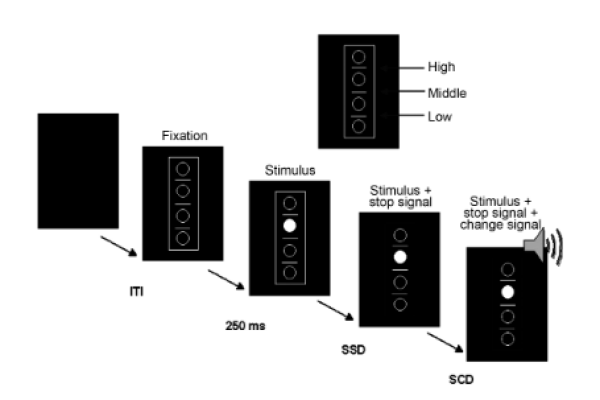2013-03-14

Our daily life is characterized by multiple response options that need to be cascaded in order to avoid overstrain of restricted response selection resources. While response selection and goal activation in action cascading are likely driven by a process varying from serial to parallel processing, little is known about the underlying neural mechanisms that may underlie interindividual differences in these modes of response selection. To investigate these mechanisms, we used a stop–change paradigm for the recording of event-related potentials and standardized low resolution brain electromagnetic tomography source localizations in healthy subjects. Systematically varying the stimulus onset asynchrony (the temporal spacing of “stop” and “change” signals), we applied mathematical constraints to classify subjects in more parallel or more serial goal activators during action cascading. On that basis, the electrophysiological data show that processes linking stimulus processing and response execution, but not attentional processes, underlie interindividual differences in either serial or parallel response selection modes during action cascading. On a systems level, these processes were mediated via a distributed fronto-parietal network, including the anterior cingulate cortex (Brodman area 32, BA32) and the temporo-parietal junction (BA40). There was a linear relation between the individual degree of overlap in activated task goals and electrophysiological processes.

Our daily life is characterized by multiple response options that need to be cascaded in order to avoid overstrain of restricted response selection resources. While response selection and goal activation in action cascading are likely driven by a process varying from serial to parallel processing, little is known about the underlying neural mechanisms that may underlie interindividual differences in these modes of response selection. To investigate these mechanisms, we used a stop–change paradigm for the recording of event-related potentials and standardized low resolution brain electromagnetic tomography source localizations in healthy subjects. Systematically varying the stimulus onset asynchrony (the temporal spacing of “stop” and “change” signals), we applied mathematical constraints to classify subjects in more parallel or more serial goal activators during action cascading. On that basis, the electrophysiological data show that processes linking stimulus processing and response execution, but not attentional processes, underlie interindividual differences in either serial or parallel response selection modes during action cascading. On a systems level, these processes were mediated via a distributed fronto-parietal network, including the anterior cingulate cortex (Brodman area 32, BA32) and the temporo-parietal junction (BA40). There was a linear relation between the individual degree of overlap in activated task goals and electrophysiological processes.